The conference
The 52nd ISCA, which was held in Tokyo from June 21 to 25, was just completed. One notable thing for this year ISCA is the high number of registrations (1200+), a big surge from 2023 (800+) and 2004 (600+). This was even after the registration was temporarily closed and another time after the cap was met. It felt “crowded” (or “lively”, depending on one’s perspective). Such fluctuations make it challenging for the organizers to plan as they had to book venues long before they knew what the registration count would be. Prof. Hironori Kasahara, Prof. Gaudiot (co-general chairs) and Prof. Keiji Kimura (local chair) and their team did a superb job in adapting to the surge.
The excursion was to Chinzanso hotel. The banquet was held in a grand ballroom, followed by a traditional Japanese tradition of breaking sake barrels. Sixteen GC/PC/SC members, organized in groups of four, each held a wooden hammer and hit the top cover of a wooden sake barrel, to break the cover. Then we scooped sake and shouted Kampai together. Outside was a nice Japanese garden with ponds, creek, waterfall, and a pathway leading up to a three-story pagoda. What was special were the Japanese fireflies and the mist cloud that blew all over, making it feel like we were standing on clouds, and the pagoda floating in the clouds.
The main program
Preceded by two days of workshops and tutorials, the main conference spanned over three full days, with 10 sessions, most were three-way parallel. Each session had 4-5 papers, each paper was presented for 20 minutes, including Q&A. Each session was followed by a poster session. This gave sufficient time for speakers to present the key ideas of their papers, answering a few questions, and allow more extensive discussion during the poster session. I like this format, especially in contrast to some conferences that provide 15 minutes or less to present.
The theme of the conference was sustainability. Before the conference reception on Sunday, there was a talk by Yale Patt on sustainability, where Yale covered various computer architecture design aspects that should be revisited (e.g. why still have a 4KB page?). The talk was followed by a special panel on sustainable computer architecture, participated by Dejan Milojiic, Wen-Mei-Hwu, Norm Jouppi, Hironori Kasahara, Yale Patt, Guri Sohi, and Carole-Jean Wu. Carole pointed out recent data showing that while only 0.2% of failures are hardware, those failures contributed to 19% of the runtime, and that embodied carbon (due to manufacturing) can be quite multiple times higher than operational carbon. Hironori discussed the role of compiler and parallelization in increasing computing sustainability. Norm pointed out that models are in flux, and sustainability will likely come from better models, hence machines should not be too specialized for a particular model and should be well-balanced instead. Wen-Mei encouraged the audience to question if current system design philosophy is still appropriate to solve future problems as the OS was still designed with past constraints in mind. For example, it still assumes large access latency and small bandwidth to the storage system, and the load/store interface places a hurdle for large-scale reliability (one failed load may bring the system down).
ISCA had two plenary keynotes. Satoshi Matsuoka talked about Seymour Cray’s legacy, and the symbiosis of AI and HPC, for example using AI to help bridge the programmability gap for purpose-built heterogeneous architecture. Todd Austin and Fitsum Andargie talked about their perspective in zero trust architecture, including a secure processor that processes data in ciphertext except in functional units. They ended the talk discussing Michigan-Adis Ababa collaboration and encouraged the audience to also consider similar collaborations.
ISCA sessions varied in topics, from microarchitecture (still alive and well!) to domain-specific architectures, security, AI and machine learning, quantum computing, and storage systems. There were many interesting papers, but unfortunately I could only attend a small subset of them. Among those, a few things caught my eyes: wafer-scale chip (Session 1A), cache compression, precise exception (with hand-drawn slides), intermittent computing prefetching (Session 2), CXL SSD integration, in-storage acceleration (Session 3C) and DeepSeek (Session 9A).
The venue
ISCA was held on the Waseda University campus, across four buildings. One of the buildings houses the flagship Okuma auditorium. It has a beautiful architecture that is almost 100 years old (1927), with a skylight dome that looks like the sun, surrounded by lights that resemble planets. The auditorium has 1123 seats and a smaller one in the same building around 300 seats. The auditorium housed important events such as lectures and graduations, including a lecture by US President Bill Clinton in 1993.
The building around Okuma auditorium was beautiful too. Next to the auditorium is Okuma garden. While small, it was a meticulously well-designed Japanese garden that oozes tranquility, a favorite picnic spot for students. Right at the entrance, there is an Okuma cafe where you can buy lunch, drink, and snacks. Within a 7 minute walk there was a 1000-year old Ana-Hachimangu Shrine. The Waseda University History Museum was one block away, which tells the story of how the university was founded and evolved over the years.
Today, Waseda University is an elite university, with alumni serving or having served in high government positions (e.g., nine former prime ministers) and business leaders (e.g. Samsung founder, Sony co-founder, etc.). But there was a time in its early years the university was struggling for its existence and was labeled as a rebel university. Yet the university endured and then prospered. I think the founders chose a good mission statement, “…the preservation of the independence of scholarship, the promotion of practical application of scholarship, and the fostering of good citizens.” These principles, especially the independence of scholarship, remain just as relevant in academia worldwide today, as it was back then, and also embodies the spirit of the computer architecture community.
The award luncheon was held on Tuesday morning. A subset of the awardees includes André Seznec (Eckert Mauchly award), Joel Emer (Alan B Berenbaum Distinguished Service Award), and Carole Wu (Maurice Wilkes award).
The future
In contrast to prior years, the location of conferences plays a much bigger role in their success than in the past. ISCA 2025 drew heavy participation from researchers in Asia (Japan, China, and South Korea add to ~57% of the attendees), but probably reduced participation from researchers in North America (~24%). In addition to the usual constraints of travel distance and costs, increasingly there have been concerns on visas and travel abroad. These effects seem broad-based as well, for example Security & Privacy conference this year in San Francisco reported a roughly 10% decrease in attendance compared to the year before (also in San Francisco), even though there was a marked increase in the number of submitted papers.
ISCA 2026 will be held in Raleigh, and 2027 in Atlanta (as an ACM/FCRC event). I hope by then, the travel/visa situation will have improved, so that the computer architecture community can continue to robustly exchange ideas and network and not fragment.
Reflections
The conference went smoothly overall. It was a very enjoyable conference and memorable to me. I want to give a big applause to Prof. Keiji Kimura, Japan Operation (Local Arrangements) and Video Chair, and his team, who did the heavy lifting and worked tirelessly in making ISCA smooth for all its 1280 attendees. Keiji is the Director of Green Computing System Research Organization at Waseda University. He has also been a good friend for ~25 years, since when we were both still PhD students.
Having served as general co-chair of ISCA in 2023, I am well aware of the meticulous planning, the amount of work, and the enormous team of enthusiastic volunteers that are needed to run a successful conference. For that reason, I am particularly proud of the architecture community for how willing they are in organizing, volunteering, and supporting one another. For example, four generations of general co/chairs were present at the conference (myself ISCA 2023, Augusto Vega ISCA 2024, Hironori Kasahara and Jean-Luc Gaudiot ISCA 2025, and Huiyang Zhou ISCA 2026), passing tips and advice, and giving encouraging words, to future organizers.
A Few Photos
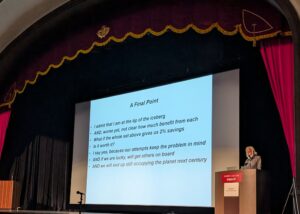
Yale Patt’s talk on Sunday, June 22, 2025
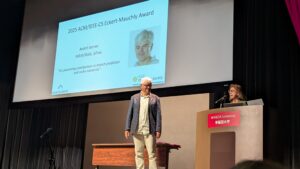
André Seznec receiving Eckert-Mauchly Award
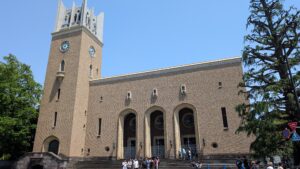
Venue: Okuma Auditorium
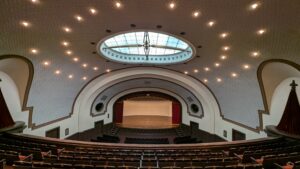
Venue: Okuma Auditorium

Okuma Garden
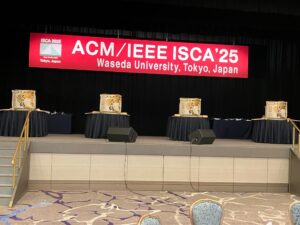
Venue: banquet hall with sake drums
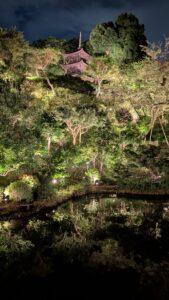
Firefly viewing at Chinsanzo hotel garden
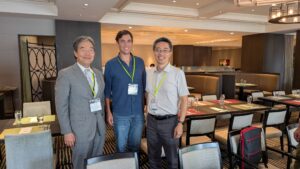
General co-chairs of three years of ISCA: Kasahara (‘25), Vega (‘24), Solihin (‘23). Gaudiot (’25), Mocskos (’24), and Heinrich (’23) were unfortunately not in the photo.
About the author
Yan Solihin is Charles N. Millican professor of computer science, and Director for Cyber Security and Privacy cluster at the University of Central Florida. He is a member of ISCA steering committee and served as a general co-chair of the 50th ISCA.
Disclaimer: These posts are written by individual contributors to share their thoughts on the Computer Architecture Today blog for the benefit of the community. Any views or opinions represented in this blog are personal, belong solely to the blog author and do not represent those of ACM SIGARCH or its parent organization, ACM.


